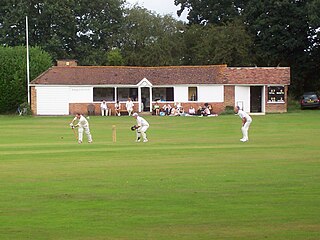Places
- Hadlow, Kent
Hadlow Cricket Club was one of the early English cricket clubs, formed in the early to mid eighteenth century. Hadlow is a village in the Medway valley near Tonbridge in Kent.

Hadlow College is a further and higher education college in Hadlow, Kent with satellite sites in Canterbury and London. The curriculum primarily covers land-based subjects including Forestry & Arboriculture, Agriculture, Conservation and Wildlife Management, Animal Management, Fisheries Management, Equine Studies, Outdoor Pursuits, Floristry, Horticulture, Garden Design, Landscape Management and sustainability. Additionally, intermediate and advanced apprenticeships are offered in Agriculture, Horticulture and Land-based Engineering.
- Hadlow Down, East Sussex
St Mark's Church is an Anglican church in the village of Hadlow Down in the district of Wealden, one of six local government districts in the English county of East Sussex. Founded in 1834 by a committed local resident who petitioned the Archbishop of Canterbury for permission to establish a chapel in the poor agricultural village, the church proved popular—despite the competing presence of two Nonconformist chapels nearby—and was extended in 1913. The stone-built church, with its tall spire and well-regarded "living churchyard" nature reserve, is now Hadlow Down's only remaining place of worship. English Heritage has listed it at Grade II for its architectural and historical importance.
Providence Chapel is a former independent Calvinistic place of worship in the village of Hadlow Down in Wealden, one of six local government districts in the English county of East Sussex. Although built in 1849, the chapel can trace its origins to the founding in 1824 of an Independent place of worship in the village. The new building was in religious use for nearly 150 years, but storm damage led to its closure and conversion into a private dwelling in 1993—although its former graveyard survives. The chapel is a Grade II Listed building.
- Hadlow Road railway station, The Wirral

Hadlow is a village in the Medway valley, near Tonbridge, Kent, England. It is in the Tonbridge and Malling district. The Saxon name for the settlement was Haeselholte. The Domesday Book records it as Haslow and in the Middle Ages it became Hadloe and then Hadlow.

Hadlow Castle was an 18th-century country house in Hadlow, Kent, England, built in the fashionable Strawberry Hill 'Gothic' style. The house was gradually enlarged and extended during the 19th century and finally demolished in the 20th, apart from a prospect tower and ancillary buildings. The surviving Grade I Listed Hadlow Tower, locally known as May's Folly, was restored in 2013.

St Mary's Church is the parish church in Hadlow, Kent, United Kingdom. The church is a Grade II* listed building.













